Wooden wonders
Find the sweet spots in the timber

This labyrinth may lack the menacing Minotaur, but an ill-suited approach to the often confounding fields of stumps and standing timber in which bass hide can leave you trampled by an even more relentless threat – the clock. Indeed, you can’t hit every piece of wood and you probably don’t need to – you just need to look for the ones with the greatest potential and use the tools most likely to produce.
Success starts with understanding what you’re looking at; and water depth plays a big role. For example, in the Red River your stump field might be 3 to 5 feet with visible structure, whereas on Table Rock Lake, the standing timber may be 30 feet tall. Different specs equal a different approach.
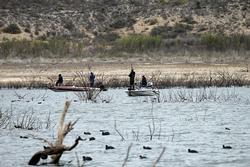 In a stump field, FLW Tour pro Brent Ehrler said he’ll looks for some type of bottom contour. Recognizing that it’s rarely just one homogenous flat with a smattering of solid objects, he tries to pinpoint a ditch running through the area and then targets those stumps sitting along the edge of the ditch.
In a stump field, FLW Tour pro Brent Ehrler said he’ll looks for some type of bottom contour. Recognizing that it’s rarely just one homogenous flat with a smattering of solid objects, he tries to pinpoint a ditch running through the area and then targets those stumps sitting along the edge of the ditch.
“In a shallow stump field, like the Red River, those fish are going to group up somewhere near where it rolls off into deeper water,” Ehrler said. “There’s a good chance it could be next to some kind of point. Let’s say that a creek channel ends and forms a little point; those fish tend to group up in areas like that.”
Texas standout Stephen Johnston explained a similar point during a past trip on Lake Amistad. The creek channels leading into spawning bays typically wind through fields of huisache brush with hardwood trees seemingly scattered randomly through the area. Actually, closer inspection reveals replicable patterns.
“When a creek makes a bend to the left or a bend to the right, that’s an intersection for those fish,” he said. “Those fish swim in so far and they’ll get in a bend and sit there. I can look at the mapping area (of my fishfinder) and see where those bends are.”
Complementing the electronics, Johnston identified a surface level indicator.
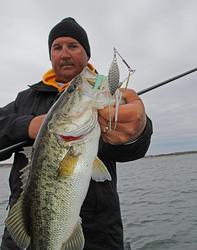 “The hardwoods will be on the inside bend of a where the creek was,” he said. “A lot of people just come in, put the trolling motor down and start fishing without taking just a few minutes to look around and see what they’re looking at. You can look for the hardwoods and look for the gaps between the mesquite trees going through here – that’s where the creeks make the swings.”
“The hardwoods will be on the inside bend of a where the creek was,” he said. “A lot of people just come in, put the trolling motor down and start fishing without taking just a few minutes to look around and see what they’re looking at. You can look for the hardwoods and look for the gaps between the mesquite trees going through here – that’s where the creeks make the swings.”
For Johnston’s fellow Texan Russell Cecil, identifying particular depth zones weighs heavily in his timber plan. For example, a few bites midway down the edge of a slough reaching from the main channel into a stump field gives him a scenario and depth zone to look for. If the bite fizzles, he’ll move up or down on those edges to see if the fish relocated. Learning to mentally breakdown a bunch of trees, Cecil said, will save you a lot of time.
“The ability to read this timber and know how these sloughs and ridges are running is the key,” Cecil said. “You have to understand what trees grow in what kind of areas. The cypress trees traditionally grow in the lower areas, so you have cypress trees that are actually in the sloughs. The hardwoods grow on the ridges or the creek banks. You’re trying to look at these (dead) trees and determine which kind they are and have some kind of mental picture of what was going on out here before it flooded.”
Pointing the way
Now a point is a point, regardless of where it occurs and fish like points for several reasons. For one thing, points present natural reference locations that fish use when traversing to and from deeper water. They’re also great feeding areas because of their ambush potential and current-blocking benefits. And, of course, there’s always the simple explanation of something different in the contour – a place fish can slide up or down to suit their comfort and practical needs.
In deep standing timber, Ehrler might fish over the tree tops, but prefers to look for points because bass relate to the sides much the same as they do with the edges of a shallow stump field ditch. Graphing the area, he’ll look for the spots with a void of timber, as this indicates the point’s deeper drop-off edges.
“The fish will use that timber as backing,” Ehrler said. “They’ll sit up against it look out at the void – the deeper water – and use that as ambush points.
“Those are two completely different scenarios, but he fish are doing relatively the same thing. They’re using that stump field or they’re using those trees as their backdrop, or their home and they’re looking out so when something swims by, they can dart out, eat it and go right back to where they feel comfortable and safe.”
Signs of promise
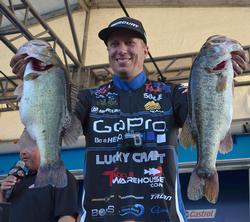 As Ehrler notes, voids in deep wood cover means a significant depth increase, whereas a void in a shallow stump field usually indicates a skinny spot. With the latter, anglers often take advantage of low-water conditions to remove some of the shallowest structure to improve navigational safety. This, and any other feature distinguishing an area from its surroundings, merits attention.
As Ehrler notes, voids in deep wood cover means a significant depth increase, whereas a void in a shallow stump field usually indicates a skinny spot. With the latter, anglers often take advantage of low-water conditions to remove some of the shallowest structure to improve navigational safety. This, and any other feature distinguishing an area from its surroundings, merits attention.
“In shallower water, it seems like any irregularity is a good thing,” Ehrler said. “In a field of (emergent) timber where all the trees are standing up, if you see one that’s laying over, there’s a chance that a bass will be sitting under that (different tree). It’s just something different out of the norm that those fish will hold on.
“You have way too many targets to hit and the one that’s odd is usually the one that has fish on it.”
Modern sonar products greatly improve your chances of finding something cool. Using his Humminbird 360 on his bow allows Ehrler to snoop around with a view of everything he’s approaching or passing.
“That’s where you can find those trees laying down,” he said. “If you’re looking at the surface and you see all that pole timber, well now I have the ability to see those laydown trees that are under that water.
Maybe someone cut down a tree when the water was low, or maybe it snapped in an ice storm. Well, now you have a laydown on the bottom. I’m not looking for a visible tree that’s laying from dry land into the water. Now, I can fish those for those subsurface laydowns that you wouldn’t find unless you saw it on your Side Image.”
Also, peaking into a field of emergent trees and brush, you might spot strands of hydrilla hanging from the wood when the water’s down. Take this as a good sign of grass growth – a great complement to wood cover and a slam dunk pre-spawn scenario.
“That grass will give pre-spawn fish a place to stage before they move up,” Johnston said. “The grass provides warmth, cover and feeding opportunities.”
Birds standing on timber – Cecil points said this indicates bait in the area. Herons, egrets and the like do this for a living, so if they’re investing time to balance on a piece of wood, you can bet there’s food in the area. You can also bet that this won’t go unnoticed by the big green bullies below the surface.
Throw what you know
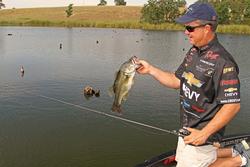 During a recent stump field mission, Chevy pro Jay Yelas noted: “A lot of times, I’ll start by fishing a crankbait through stumps to see if I can trigger those fish to bite. The key is to make that bait deflect off the cover.”
During a recent stump field mission, Chevy pro Jay Yelas noted: “A lot of times, I’ll start by fishing a crankbait through stumps to see if I can trigger those fish to bite. The key is to make that bait deflect off the cover.”
Ehrler agrees and adds this: “I want to use a search tool, like a Lucky Craft 1.5 and find a sweet spot where those fish are going to be grouped up.
“With a search bait, I can wind through there and fish effectively until I get a few bites and tell if there are a few fish in that area.”
From the deeper edges of a ditch or slough running into a South Texas bay bristling with visible wood, to those deep water points with barren sides, a jerkbait offers profound bass-tempting appeal – and not only for the chilly months. No doubt, this is a solid bet for early spring, but a minnow profile hanging there all by its lonesome is mighty tempting to a bass throughout the calendar.
ChatterBaits are an effective option for working around hydrilla growth within your stump field or standing timber. Johnston likes a V&M Lightning Blade with a swimbait trailer, but if the fish are short striking and just grabbing the tail, he’ll ditch the plastic and go with a more compact package. And if the fish slow down on that bite entirely, try the more subtle presentation of a swim jig.
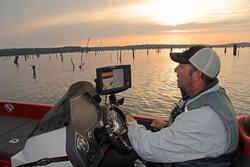 Once you identify a pattern for where the fish are holding, or if you simply notice more response on certain types of trees – overhangs, twin trees with fish-friendly gaps, hollowed-out stumps, etc. – slowing down and picking apart such targets is a good bet.
Once you identify a pattern for where the fish are holding, or if you simply notice more response on certain types of trees – overhangs, twin trees with fish-friendly gaps, hollowed-out stumps, etc. – slowing down and picking apart such targets is a good bet.
Here, flipping or pitching Texas-rigged worms and creature baits affords the weedless benefit, but don’t hesitate to send a jig into the target zone. The compact package with flaring skirt raises that craw trailer in defensive position and that’s just too much for most bass to handle.
The standard rules of thumb for color selection hold their traditional wisdom here, but Cecil won’t hesitate to intentionally mismatch his jig and trailer colors to effect a strong contrast that sometimes pushes indecisive bass over the edge. A green pumpkin/brown jig with a black/blue trailer blends some different tones of the bluegill look, but if a bass eats it, who’s gonna question it?
Get it back
When fishing in stump fields or shallow stands of timber, consider the fact that tangled root systems laid partially bare by time and water wear love to collect fishing tackle. Popping the line often loosens the snare, but attempting this mission without a lure knocker is a just a guaranteed tackle donation at some point in the day. In water less than your rod length, you might reel the tip tight to your bait and push it free.
This is probably not the preferable method any time before late spring – unless you have antifreeze in your veins. It’s also a less popular tactic in the south, where interaction with gators, moccasins and copperheads looms constantly.
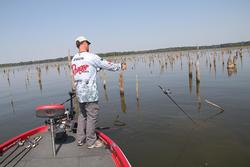 However, if all else fails, there are other options you can employ to attempt to retrieve your bait. In fact, Cecil has perhaps the most innovative cure for the deep snag: Grabbing his line between the reel and the first guide, he’ll pull backward to shuttle the rod into the water and down to the ensnared bait. Rather than reeling the bait to the rod, he sends the rod to the bait.
However, if all else fails, there are other options you can employ to attempt to retrieve your bait. In fact, Cecil has perhaps the most innovative cure for the deep snag: Grabbing his line between the reel and the first guide, he’ll pull backward to shuttle the rod into the water and down to the ensnared bait. Rather than reeling the bait to the rod, he sends the rod to the bait.